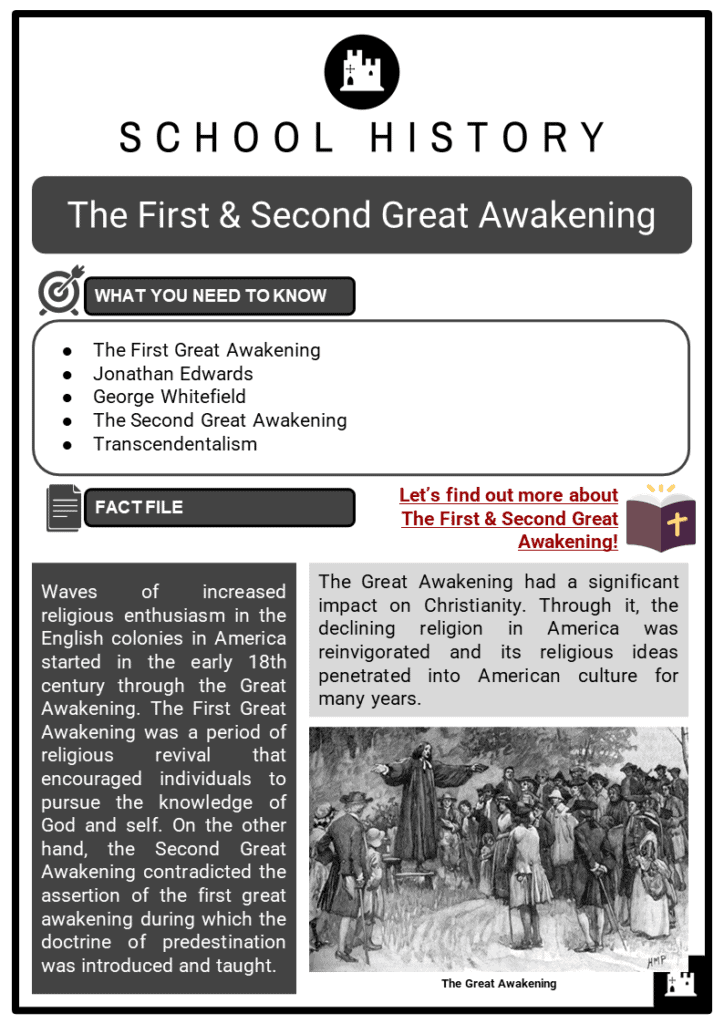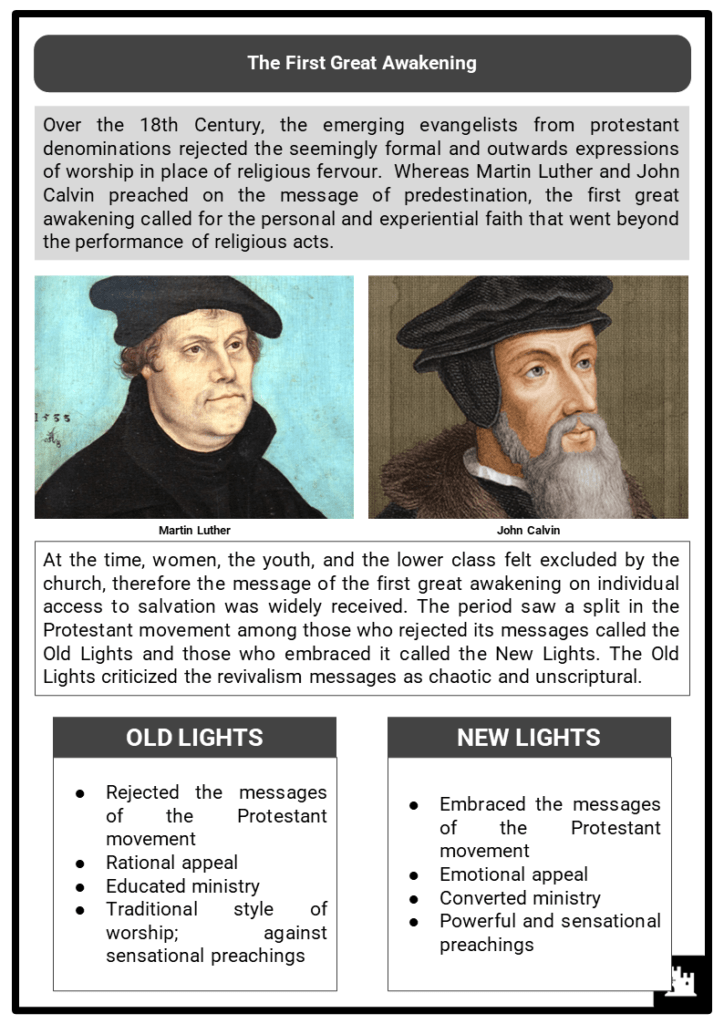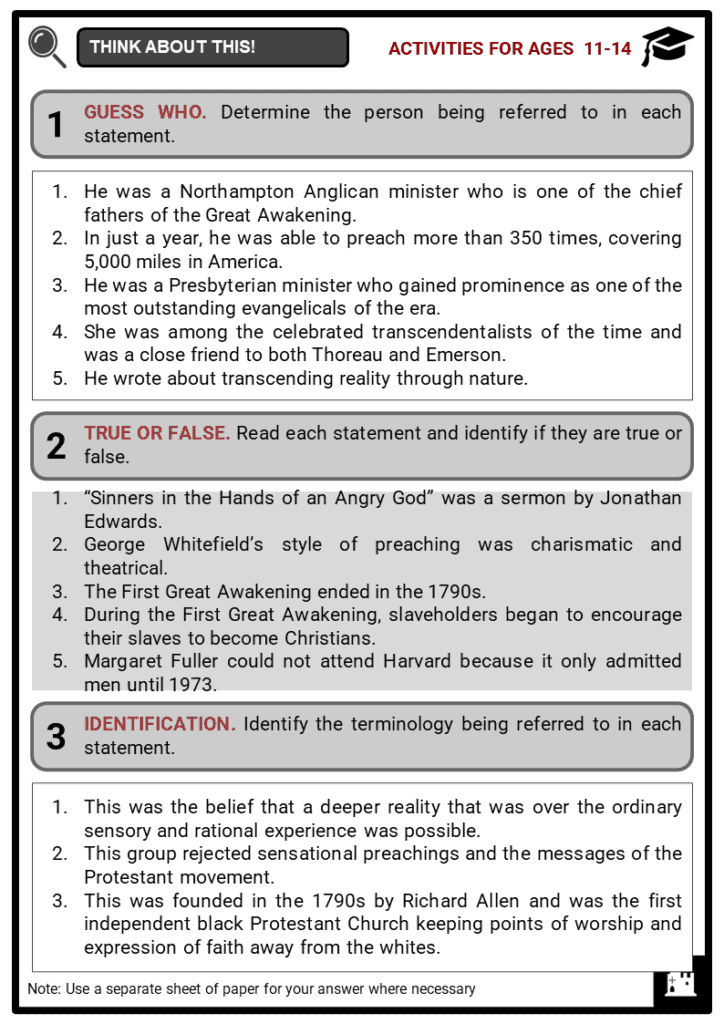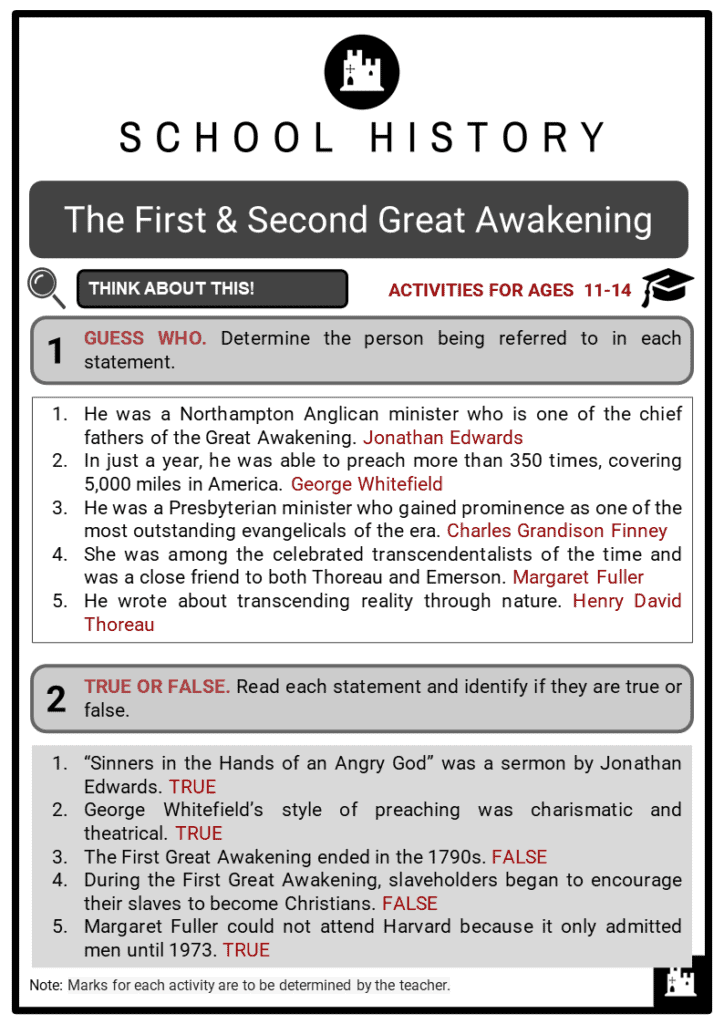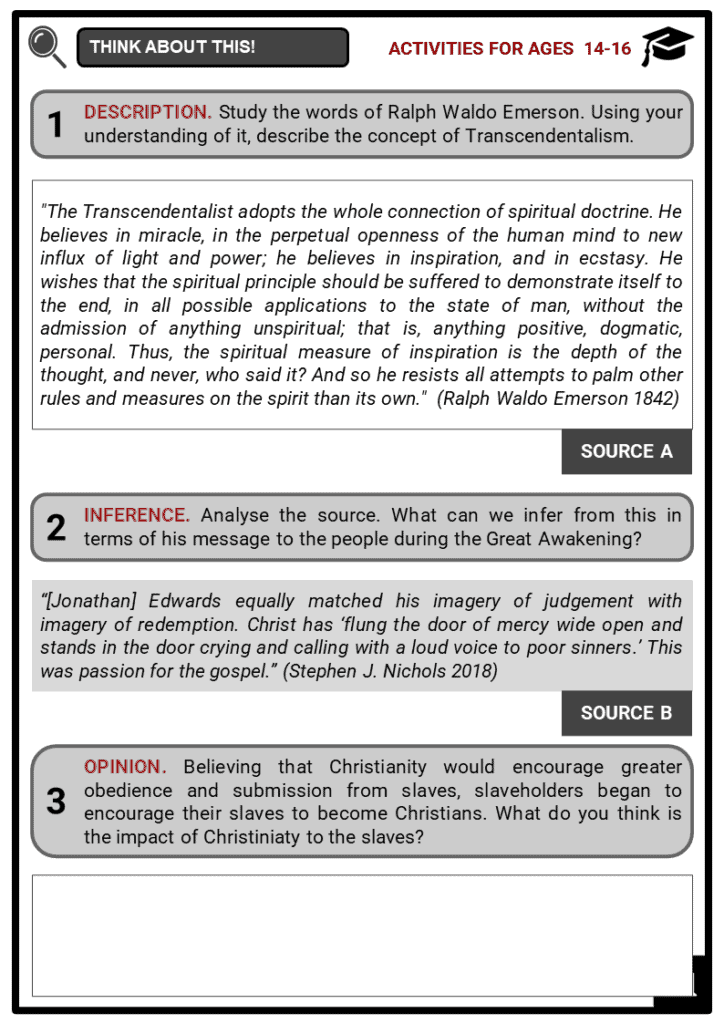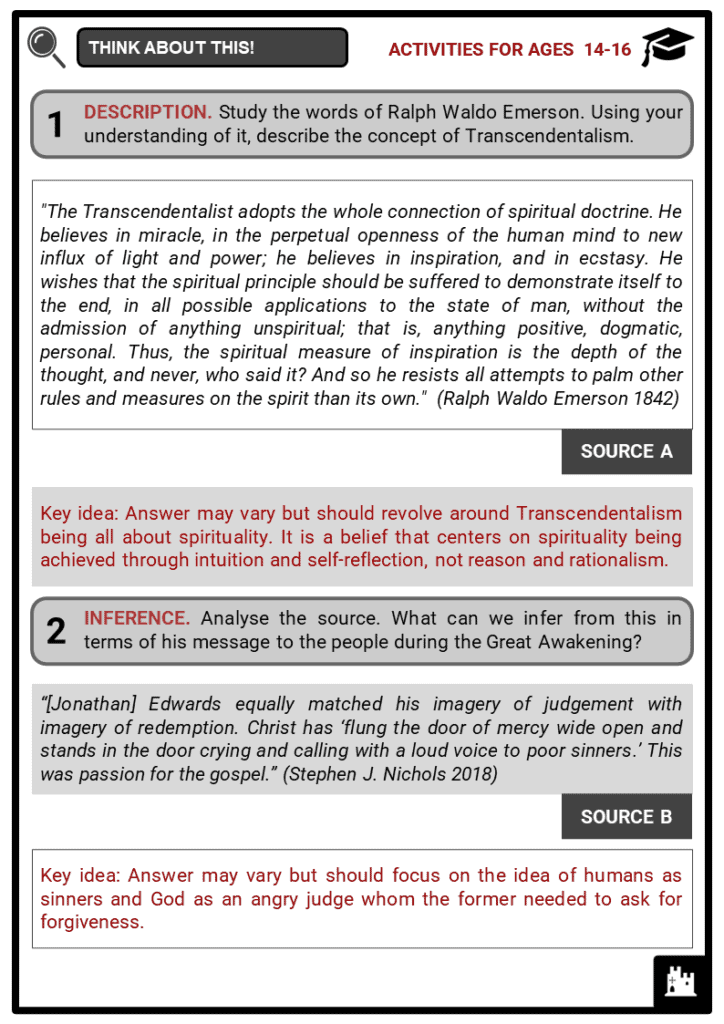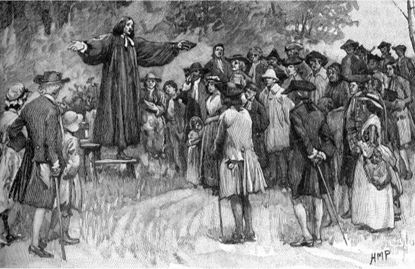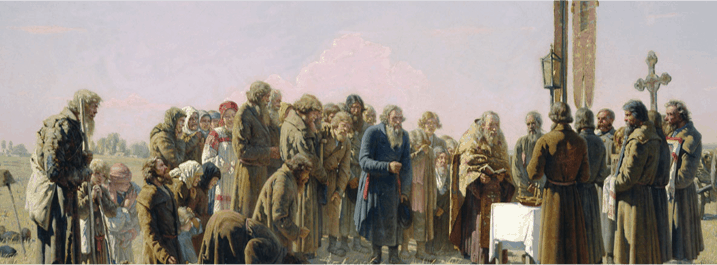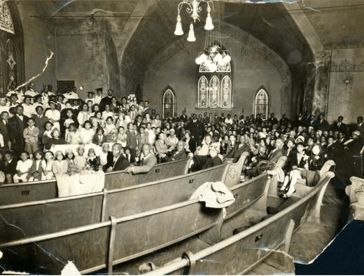Download The First & Second Great Awakening Worksheets
Do you want to save dozens of hours in time? Get your evenings and weekends back? Be able to teach The First & Second Great Awakening to your students?
Our worksheet bundle includes a fact file and printable worksheets and student activities. Perfect for both the classroom and homeschooling!
Table of Contents
Add a header to begin generating the table of contents
Summary
- The First Great Awakening
- Jonathan Edwards
- George Whitefield
- The Second Great Awakening
- Transcendentalism
Key Facts And Information
Let’s find out more about The First & Second Great Awakening!
- Waves of increased religious enthusiasm in the English colonies in America started in the early 18th century through the Great Awakening. The First Great Awakening was a period of religious revival that encouraged individuals to pursue the knowledge of God and self. On the other hand, the Second Great Awakening contradicted the assertion of the first great awakening during which the doctrine of predestination was introduced and taught.
- The Great Awakening had a significant impact on Christianity. Through it, the declining religion in America was reinvigorated and its religious ideas penetrated into American culture for many years.
The First Great Awakening
- Over the 18th Century, the emerging evangelists from protestant denominations rejected the seemingly formal and outwards expressions of worship in place of religious fervour. Whereas Martin Luther and John Calvin preached on the message of predestination, the first great awakening called for the personal and experiential faith that went beyond the performance of religious acts.
- At the time, women, the youth, and the lower class felt excluded by the church, therefore the message of the first great awakening on individual access to salvation was widely received. The period saw a split in the Protestant movement among those who rejected its messages called the Old Lights and those who embraced it called the New Lights. The Old Lights criticized the revivalism messages as chaotic and unscriptural.
- OLD LIGHTS:
- Rejected the messages of the Protestant movement
- Rational appeal
- Educated ministry
- Traditional style of worship; against sensational preachings
- NEW LIGHTS:
- Embraced the messages of the Protestant movement
- Emotional appeal
- Converted ministry
- Powerful and sensational preachings
- The first great awakening was impactful even in the States; it led to the rise of Protestant denominations such as Methodists, Presbyterians, and Baptists. The new movements were in competition with the old school protestants from the Church of England, the descendants of Puritans in America and the Quakers.
Jonathan Edwards and George Whitefield
- One of the chief fathers of the Great Awakening was Northampton Anglican minister Jonathan Edwards. His message focused on the idea of God as an angry judge whom humans needed to ask for forgiveness.
- In 1741, in Edwards’ sermon titled “Sinners in the Hands of an Angry God”, news of the message spread throughout the American colonies. He is credited for inspiring hundreds of conversions to which he documented in his book titled, “Narratives of Surprising Conversion”.
- George Whitefield was another minister who had a significant impact during the Great Awakening. He toured colonies to preach his message. In just a year, he was able to preach more than 350 times, covering 5,000 miles in America.
- Whitefield’s style of preaching was charismatic and theatrical which made thousands of people gather around to hear him speak. He preached to all common people, including Native Americans and slaves. His success convinced many English colonists to join local churches.
Second Great Awakening
- When the first great awakening ended in the 1740s, another religious revival sprung 50 years later through the Second Great Awakening of the 1790s. Though it was typically regarded as less emotionally charged as the first great awakening, it led to the founding of several colleges, seminaries, and mission societies.
- The second great awakening focused on encouraging Christians to turn away from sinful pasts, acknowledging their unworthiness before God, and accepting salvation in Christ. During this time, there was also the rejection of the doctrine of predestination as taught by Calvin over the course of the first awakening.
- The outpouring of religious fervour and revival began in Kentucky and Tennessee in the 1790s and early 1800s among the Presbyterians, Methodists, and Baptists. During the period, the American population was rapidly growing and the great leap westward characterised its territorial expansion. The awakening brought comfort in the face of uncertainty as a result of the socio-political changes in America.
- The predominant message of the time was for decency and goodness among God’s children, who were equal before God. Church membership during the period doubled in 1800–1835. The 1816 American Bible Society distributed bibles, with a “one bible, one family” objective. In 1824, the American Sunday School Union was also established, with the objective of ensuring that school children also understood the bible.
- Slaveholders also began to encourage their slaves to become Christians. In earlier days, it was feared that Christianity among slaves would mean that slavery would be challenged on the basis of its contradiction to the Christian values. The slaveholders, however, found a legal basis for maintaining slavery even over Christian African-Americans. Further, the whites believed that Christianity would encourage greater obedience and submission from slaves.
- This led to the establishment of African-Americans forms of worship that were consistent with their culture as opposed to white practices. The African Methodist Episcopal Church founded in the 1790s by Richard Allen and the first independent black Protestant Church were points of worship and expression of faith away from the whites.
- In the Northeastern region, Charles Grandison Finney, a Presbyterian minister, gained prominence as one of the most outstanding evangelicals of the era. He was born in 1792 in western New York and studied law in 1821 until he answered the call to be a minister of the gospel and to lead a series of revival meetings. His greatest success and impact was in Rochester, New York in 1830.
- At the time, Rochester was going through significant economic success because of the shipping at the Erie Canal. People welcomed Finney's message that spiritual success was available to the individual. The region was referred to as the “burned-over district” because of the intense religious flames that took over the area.
Transcendentalism
- In early 1820, people began believing in Transcendentalism. This was the belief that a deeper reality that was over the ordinary sensory and rational experience was possible. Transcendentalists were critical of the popular American culture of the time, especially the Jacksonian Democracy, which was referred to as “tyranny of the majority”, synonymous to rejecting individualism and embracing conformity.
- Ralph Waldo Emerson was a leading transcendentalist of this period. He was born into a religious family in 1803 and served as a Unitarian minister after graduating from Harvard Divinity School in 1820. He left the clergy after the death of his wife in 1831. He also published “Self-Reliance” which encouraged people to think for themselves and not rely on the thinking of mediocre popular culture America.
- Americans were drawn to the ideas of transcendentalism and many began writing about it. Henry David Thoreau, for one, wrote about transcending reality through nature. In 1849, he gave lectures on the importance of individuals standing for justice because of the Mexican-American war and slavery.
- Margaret Fuller was also among the celebrated transcendentalists of the time and was a close friend to both Thoreau and Emerson. She could not, however, attend Harvard because it only admitted men until 1973. Despite this, she was allowed access to its library. In 1840, she was appointed the editor of The Dial and became the editor of the New York Tribune newspaper. She died at the age of forty in a shipwreck.
- Elizabeth Palmer Peabody, who served as the business manager of the Dial and Louisa May Alcott, author of “Little Women”, were among the leading female transcendentalists. Walt Whitman in his 1855 publication of twelve poems was also regarded as a great transcendentalist. He amplified the message of individual agency and demonstrated a connection of the individual with other people through the bond of transcendentalism.
- It follows therefore that transcendentalists were vocal about the abolition of slavery. Emerson is celebrated for speaking strongly against the Fugitive Slave Law that provided for the capture and return of slaves seeking refuge in other states. He also spoke against the Kansas Nebraska Act of 1854 that allowed for popular initiative over the question of slave policy for settlers in Kansas and Nebraska.
- Whereas by the 1850s, the movement had faded, the ideas and writing significantly influenced the women rights and suffrage movement and the labour movements that came in the days after.
Image sources:
- https://www.history.com/.image/t_share/MTU3ODc5MDg3NTAxODEzMDY1/george-whitefield-preaching.jpg
- https://tabletalkmagazine.com/wp-content/uploads/2019/04/2019_05_Hero3.jpg
- https://i.pinimg.com/originals/be/1b/33/be1b33b882bc0df51af8186afb82030e.jpg

